Describing and Visualizing a Water–Energy–Food Nexus System
Abstract
:1. Introduction
1.1. Background
1.2. Purpose of the Research
2. Materials and Methods
2.1. Theory and Concepts
2.2. Study Area
2.3. General Description of Ontology Engineering
2.4. General Description of Network Analysis
3. Results
3.1. Drawing Causal Linkages between WEF Resources and Their Stakeholders in Social and Natural Systems
3.2. Describing WEF Nexus Domain Ontology Including Defining the Concepts and Sub-Concepts of Trade-Offs Relating to WEF
3.3. Quantifying and Identifying Key Concepts Being Linkage Hubs in the Target WEF Nexus Domain Ontology Using the Network Analysis Method
3.4. Designing and Visualizing WEF Nexus System Maps by Centering Identified Key Concepts
4. Discussion
4.1. Nexus System Map Focusing on Human–Nature Interaction
4.2. Potential Use of the Nexus System Map
5. Future Directions
Author Contributions
Funding
Conflicts of Interest
References
- Hoff, J. Understanding the nexus. In Background Paper for the Bonn 2011 Conference: The Water, Energy and Food Security Nexus, Bonn, Germany, 16–18 November 2011; Stockholm Environment Institute (SEI): Stockholm, Sweden, 2011. [Google Scholar]
- Keskinen, M. Bringing Back the Common Sense? Integrated Approaches in Water Management: Lessons Learnt from the Mekong. Ph.D. Thesis, Aalto University, Helsinki, Finland, 3 September 2010. [Google Scholar]
- WCED. Our Common Future, World Commission on Environment and Development (WCED); Oxford University Press: Oxford, UK, 1987. [Google Scholar]
- Margerum, R.D.; Born, S.M. Integrated environmental management: Moving from theory to practice. J. Environ. Plan. Man. 1995, 38, 371–392. [Google Scholar] [CrossRef]
- Mitchell, B. Integrated water management. In Integrated Water Management: International Experiences and Perspectives; Belhaven Press: London, UK, 1990. [Google Scholar]
- Klein, J.T.; Newell, W.H. Advancing interdisciplinary studies. In Handbook of the Undergraduate Curriculum: A Comprehensive Guide to Purposes, Structures, Practices, and Change; Jossey-Bass: San Francisco, CA, USA, 1997. [Google Scholar]
- National Academy of Sciences, National Academy of Engineering and Institute of Medicine. Facilitating Interdisciplinary Research; National Academic Press: Washington, DC, USA, 2005. [Google Scholar]
- Repko, A.F.; Szostak, R. Interdisciplinary Research: Process and Theory; SAGE: Thousand Oaks, CA, USA, 2008. [Google Scholar]
- Bazilian, M.; Rogner, H.; Howells, M.; Hermann, S.; Arent, D.; Gielen, D.; Steduto, P.; Mueller, A.; Komor, P.; Tol, R.S.; et al. Considering the energy, water and food nexus: Towards an integrated modelling approach. Energy Policy 2011, 39, 7896–7906. [Google Scholar] [CrossRef]
- Harwood, S. In search of a (WEF) nexus approach. Environ. Sci. Policy 2018, 83, 79–85. [Google Scholar] [CrossRef]
- Bizikova, L.; Roy, D.; Swanson, D.; Venema, H.D.; McCandless, M. The Water–Energy–Food Security Nexus: Towards a Practical Planning and Decision-Support Framework for Landscape Investment and Risk Management; The International Institute for Sustainable Development (IISD): Winnipeg, MB, Canada, 2013. [Google Scholar]
- Climate and Earth System Modeling: Integrated Assessment Research. Available online: https://climatemodeling.science.energy.gov/program/integrated-assessment-research (accessed on 28 January 2018).
- Kling, C.L.; Arritt, R.W.; Calhoun, G.; Keiser, D.A. Integrated assessment models of the food, energy, and water nexus: A review and an outline of research needs. Ann. Rev. Resour. Econ. 2017, 9, 143–163. [Google Scholar] [CrossRef]
- The Nexus between Energy, Food, Land Use, and Water: Application of a Multi-Scale Integrated Approach. Available online: http://www.nexus-assessment.info/ (accessed on 28 January 2018).
- Haberl, H.; Wiedenhofer, D.; Erb, K.-H.; Görg, C.; Krausmann, F. The material stock–flow–service nexus: A new approach for tackling the decoupling conundrum. Sustainability 2017, 9, 1049. [Google Scholar] [CrossRef]
- Yang, Y.C.E.; Wi, S. Informing regional water-energy-food nexus with system analysis and interactive visualizations: A case study in the Great Ruaha River of Tanzania. Agric. Water Manag. 2018, 196, 75–86. [Google Scholar] [CrossRef]
- Stirling, A.; Nexus Network Team; Science Policy Research Unit of University of Sussex Business School (SPRU); Social, Technological and Environmental Pathways to Sustainability (STEPS) Centre. Developing ‘Nexus Capabilities’: Towards Transdisciplinary Methodologies; The Nexus Network, Discussion Paper; University of Sussex: Brighton, UK, 2015. [Google Scholar]
- White, D.; Jones, J.; Maciejewski, R.; Aggarwal, R.; Mascaro, G. Stakeholder analysis for the food-energy-water nexus in Phoenix, Arizona: Implications for nexus governance. Sustainability 2017, 9, 2204. [Google Scholar] [CrossRef]
- Yusa, Y.; Kamiyama, K.; Kawano, T. Long-Term Change in Chemical Composition of Hot Spring in the Southern Part of Beppu Area; Reports of Oita Prefecture Hot Spring Research Society; Oita Prefecture Hot Spring Research Society: Oita, Japan, 1989. [Google Scholar]
- Yusa, Y.; Kamiyama, K.; Kawano, T. Long-Term Change in Chemical Composition of Hot Spring in the Northern Part of Beppu Area; Reports of Oita Prefecture Hot Spring Research Society; Oita Prefecture Hot Spring Research Society: Oita, Japan, 1990. [Google Scholar]
- Mizoguchi, R. Ontology Kougaku (Ontology Engineering); Ohmsha: Tokyo, Japan, 2005. [Google Scholar]
- Van Ittersum, M.K.; Ewert, F.; Heckelei, T.; Wery, J.; Olsson, J.A.; Andersen, E.; Bezlepkina, I.; Brouwer, F.; Donatelli, M.; Flichman, G.; et al. Integrated assessment of agricultural systems: A component-based framework for the European Union (SEAMLESS). Agric. Syst. 2008, 96, 150–165. [Google Scholar] [CrossRef]
- Frey, U.; Cox, M. Building a diagnostic ontology of social-ecological systems. Int. J. Commons 2015, 9, 595–618. [Google Scholar] [CrossRef]
- Kumazawa, T.; Kozaki, K.; Matsui, T.; Saito, O.; Ohta, M.; Hara, K.; Uwasu, M.; Kimura, M.; Mizoguchi, R. Initial design process of the sustainability science ontology for knowledge-sharing to support co-deliberation. Sustain. Sci. 2014, 9, 173–192. [Google Scholar] [CrossRef]
- Jansen, M. Sustainable development goals interface ontology. Presented at the International Conference on Biomedical Ontology and BioCreative (ICBO BioCreative 2016), Corvallis, OR, USA, 1–4 August 2016. [Google Scholar]
- Kozaki, K.; Kitamura, Y.; Ikeda, M.; Mizoguchi, R. Role oyobi kankei ni kansuru kisotekikousatsu ni motodsuku ontology kijyutsukankyou no kaihatsu. Trans. Jpn. Soc. Artif. Intell. (JSAI) 2002, 17, 196–208. [Google Scholar] [CrossRef]
- Luke, D.A. A User’s Guide to Network Analysis in R; Springer: New York, NY, USA, 2015. [Google Scholar]
- Stein, C.; Barron, J.; Moss, T. Governance of the Nexus: From Buzz Words to a Strategic Action Perspective; The Nexus Network, SPRU, Nexus Network Think Piece Series, Paper 003; University of Sussex: Brighton, UK, 2014. [Google Scholar]
- Kimura, M.; Masuhara, N.; Baba, K. Visualization of potential social network focusing on common recognition of small scale distributed geothermal power plant stakeholders in Beppu City, Oita Prefecture. Environ. Sci. 2017, 30, 325–335. [Google Scholar]
- Endo, A.; Kumazawa, T.; Yamada, M.; Kato, T. Design and visualization of water-energy-food nexus system and future design. J. Jpn. Soc. Water Environ. 2017, 40, 134–137. [Google Scholar]
- Mizoguchi, R. YAMATO: Yet Another More Advanced Top-Level Ontology. Available online: http://www.ei.sanken.osaka-u.ac.jp/hozo/onto_library/upperOnto.htm (accessed on 22 July 2018).
- Mizoguchi, R. Ontology Kougaku no Riron to Jissen (Theory and Practice of Ontology Engineering); Ohmsha: Tokyo, Japan, 2012. [Google Scholar]
- Endo, A.; Burnett, K.; Orencio, P.; Kumazawa, T.; Wada, C.; Ishii, A.; Tsurita, I.; Taniguchi, M. Methods of the water-energy-food nexus. Water 2015, 7, 5806–5830. [Google Scholar] [CrossRef]
- Hirota, K.; Kozaki, K.; Mizoguchi, R. Development of a conceptual map creation tool for overlooking ontologies. In Proceedings of the 22nd Annual Conference of the Japanese Society for Artificial Intelligence (JSAI 2008), Asahikawa, Japan, 11–13 June 2008; Available online: http://2008.conf.ai-gakkai.or.jp/program/paper-100387.html (accessed on 27 July 2018).
- Boardman, A.; Greenberg, D.; Vining, A.; Weimer, D. Cost-Benefit Analysis; Prentice Hall: Upper Saddle River, NJ, USA, 2010. [Google Scholar]
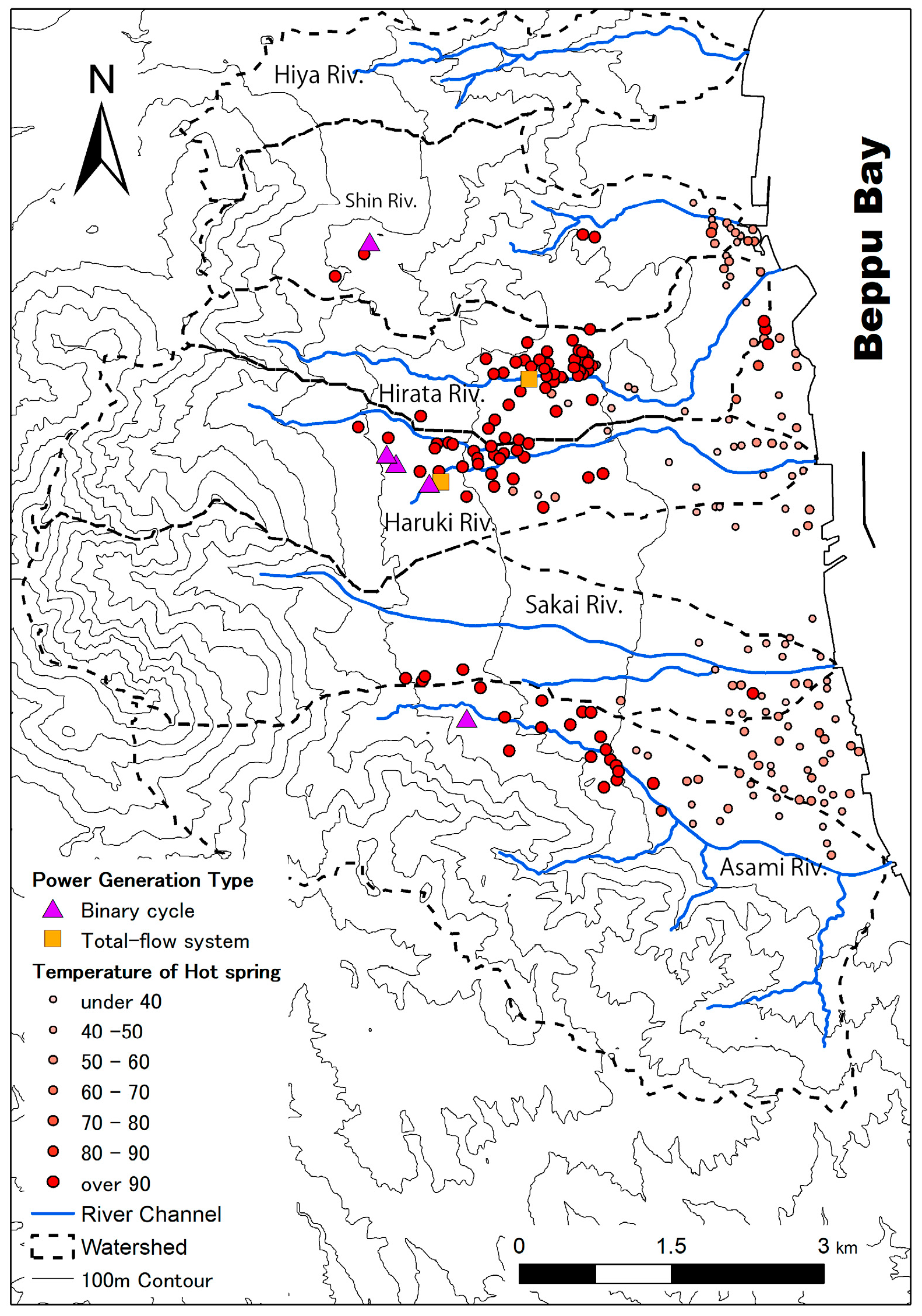
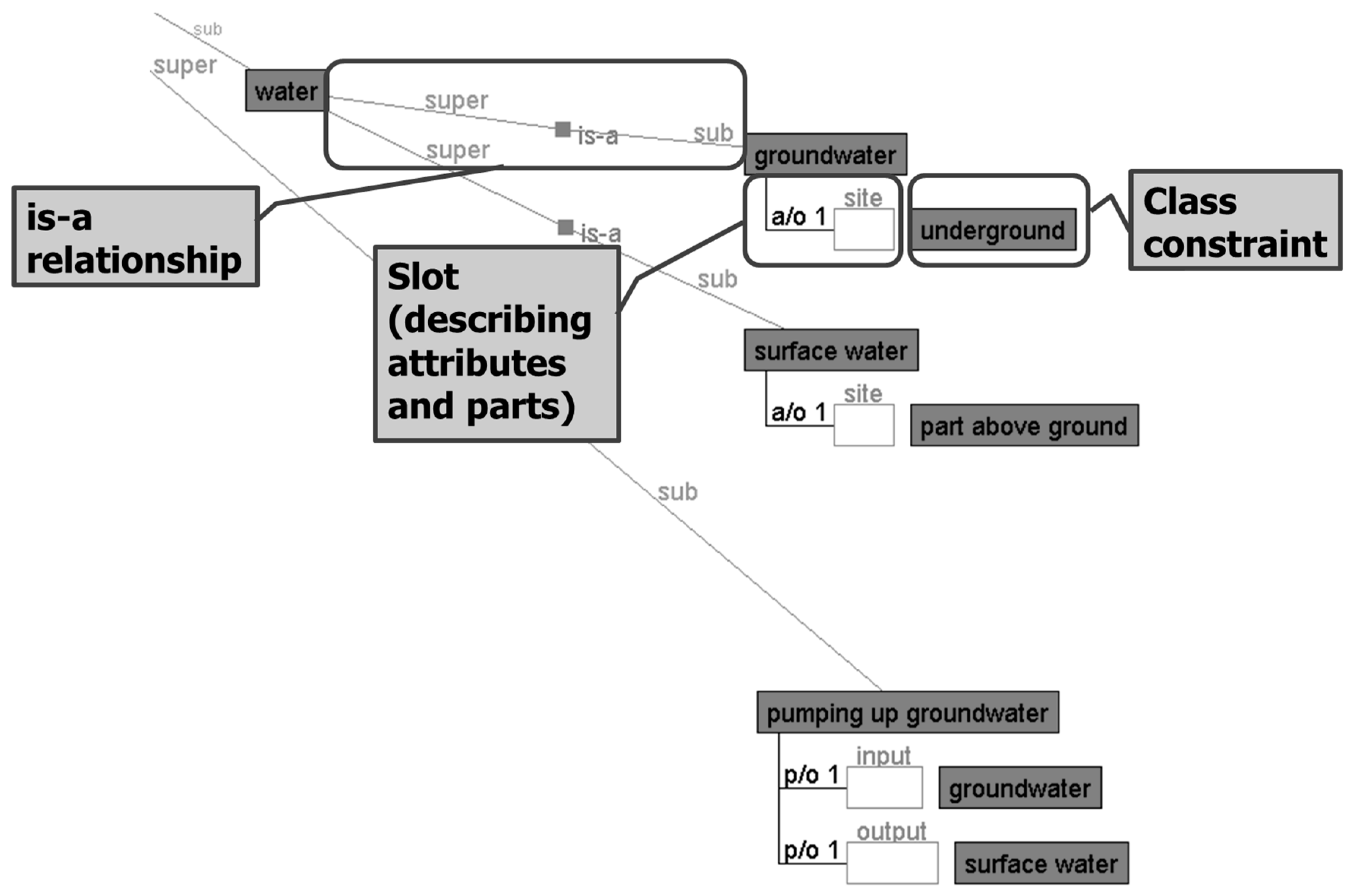
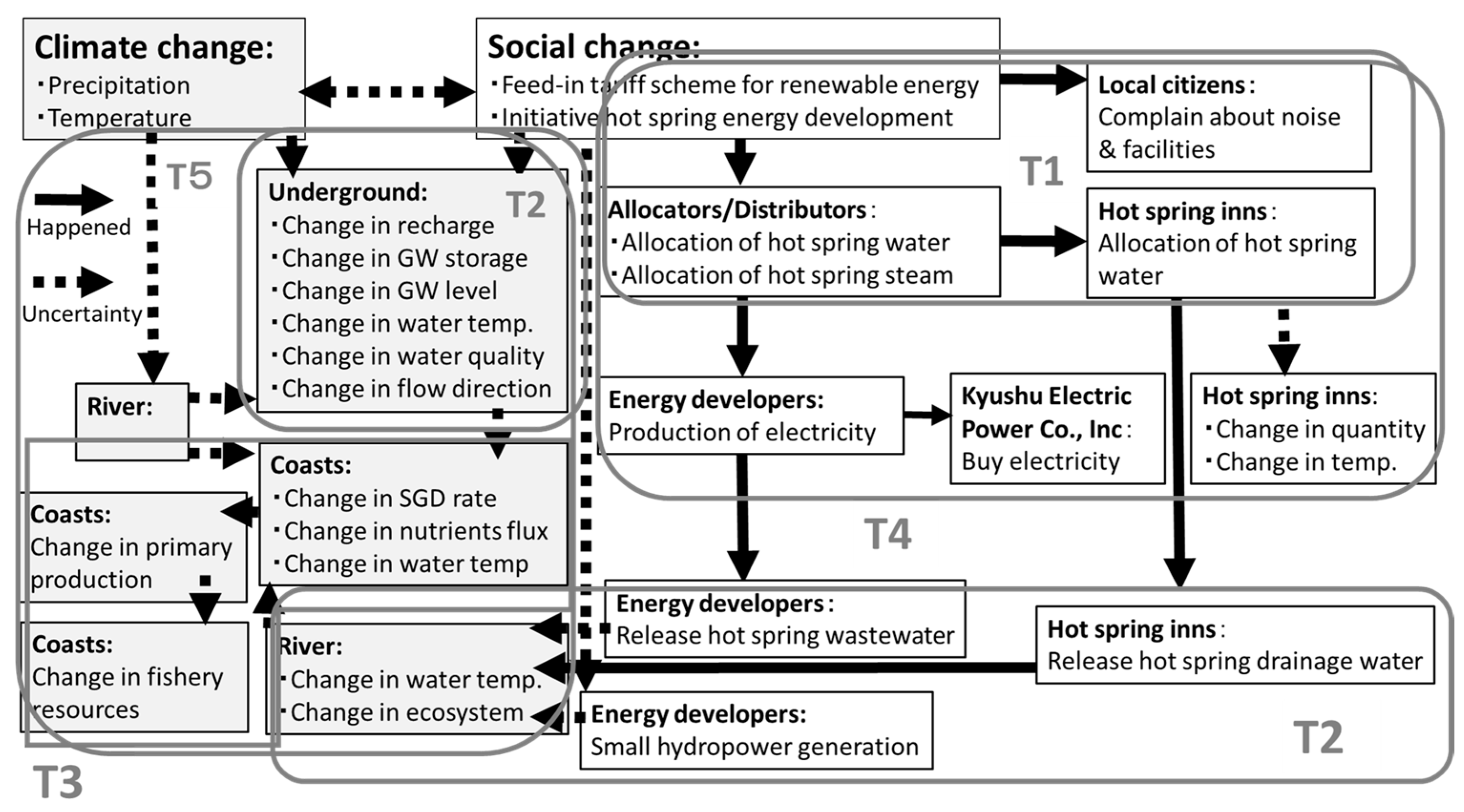

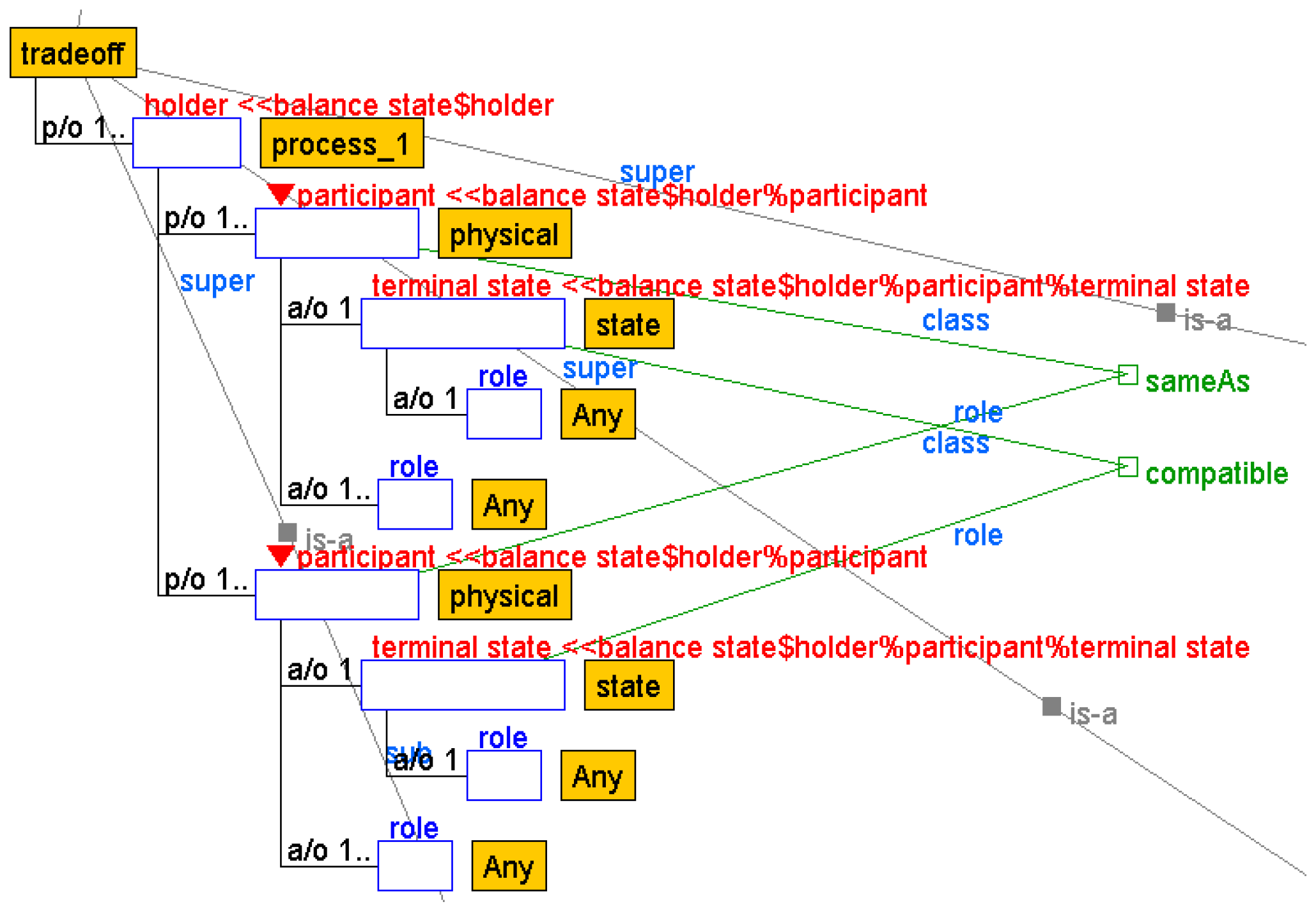
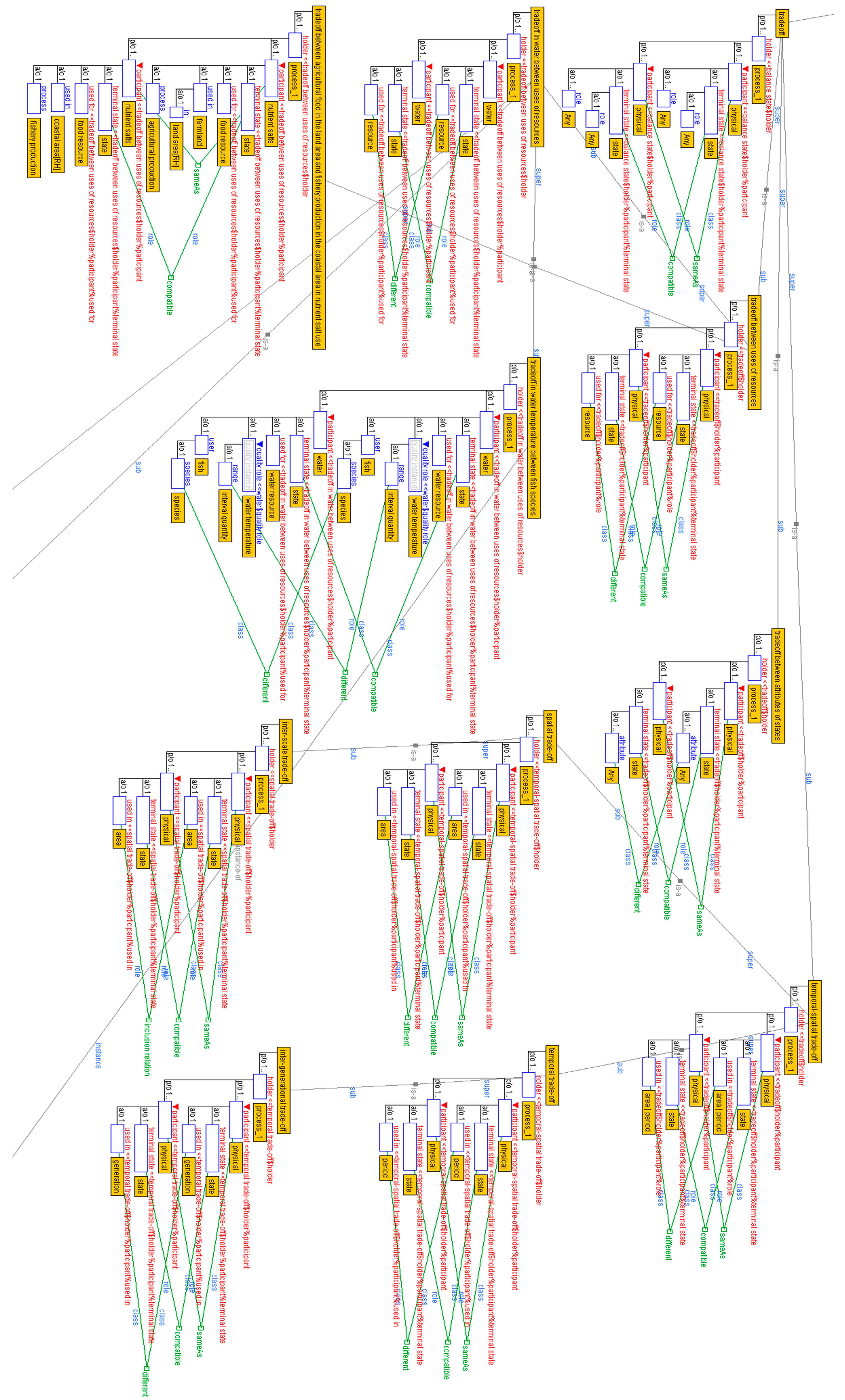
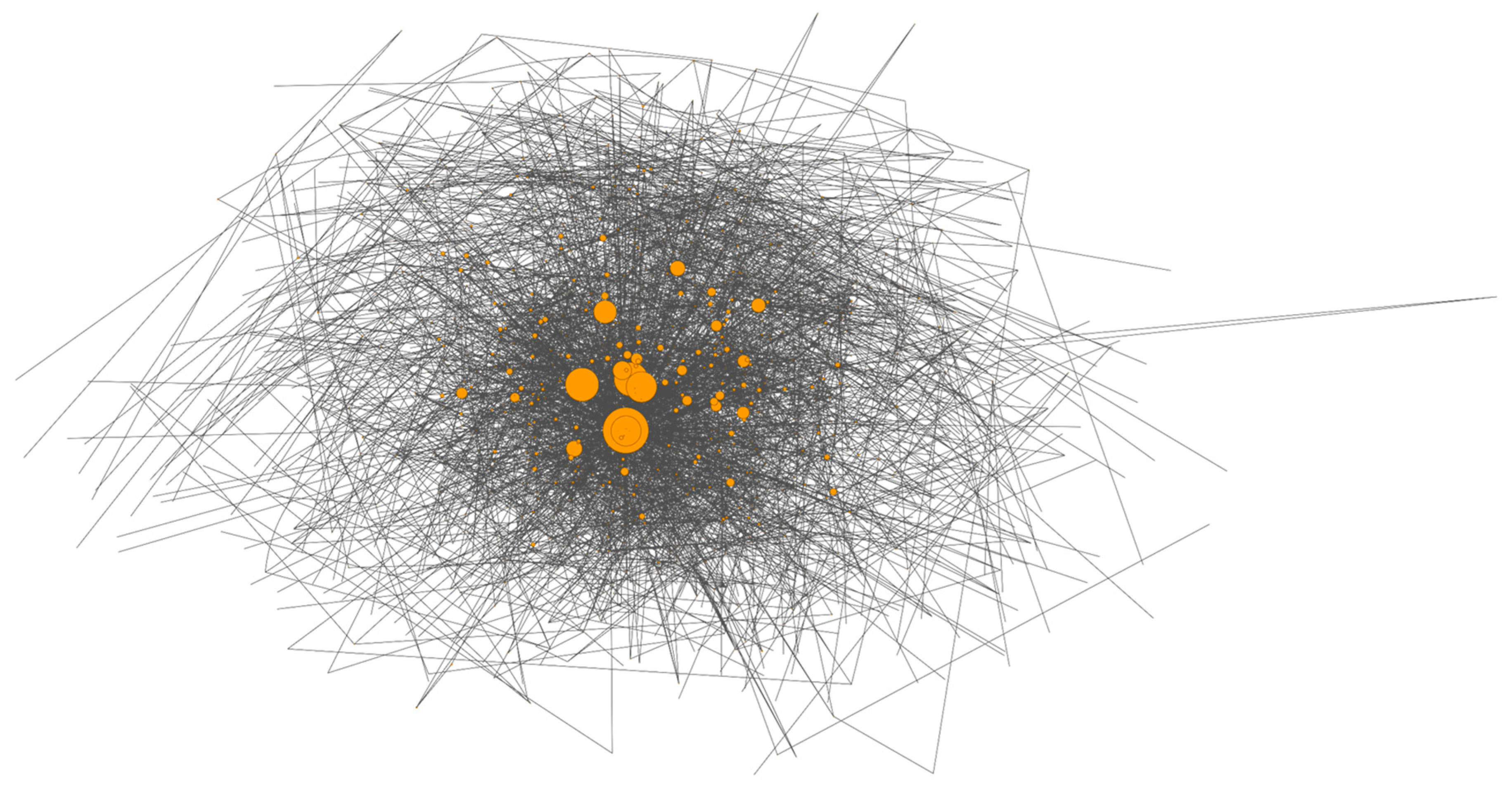
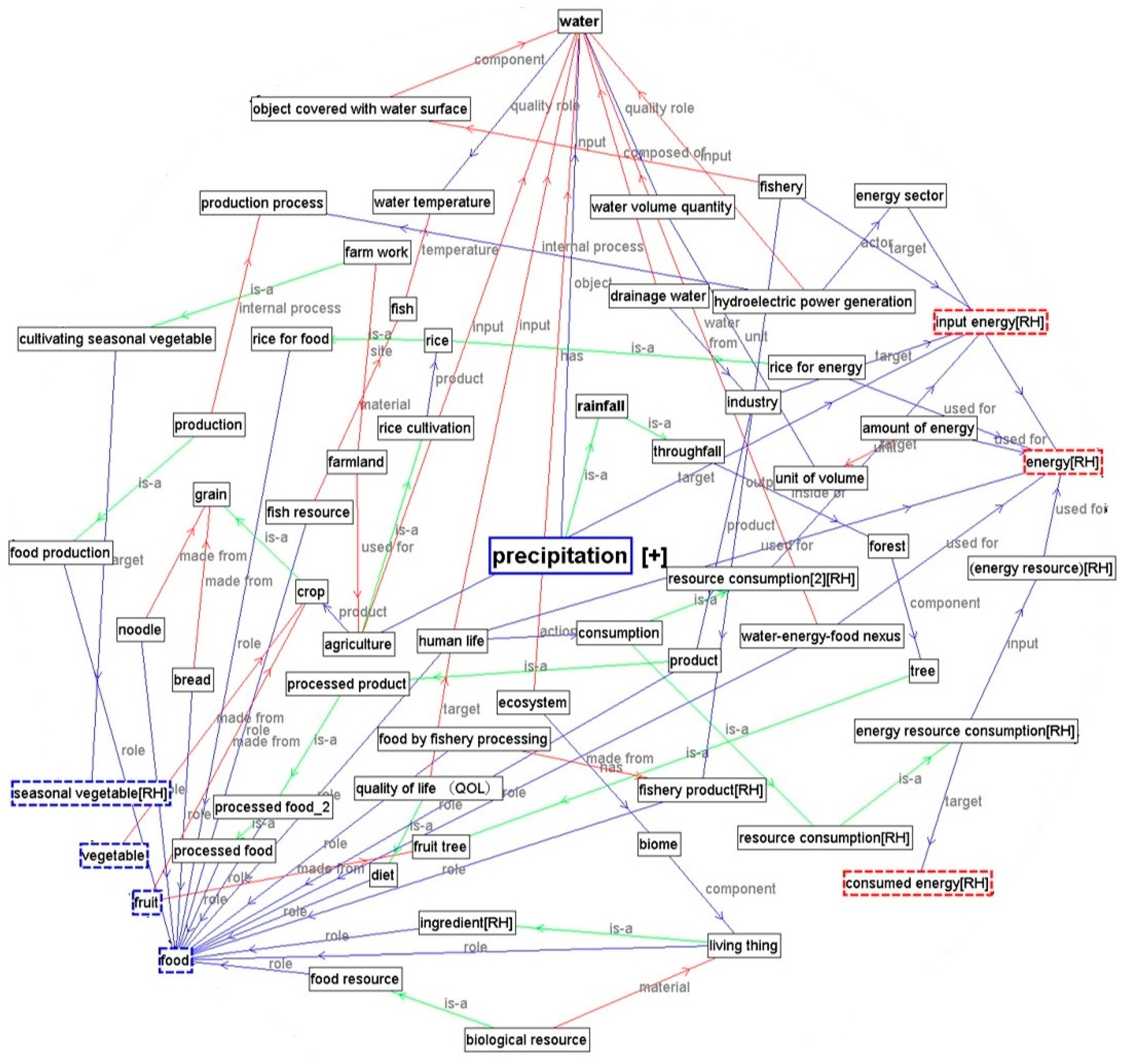
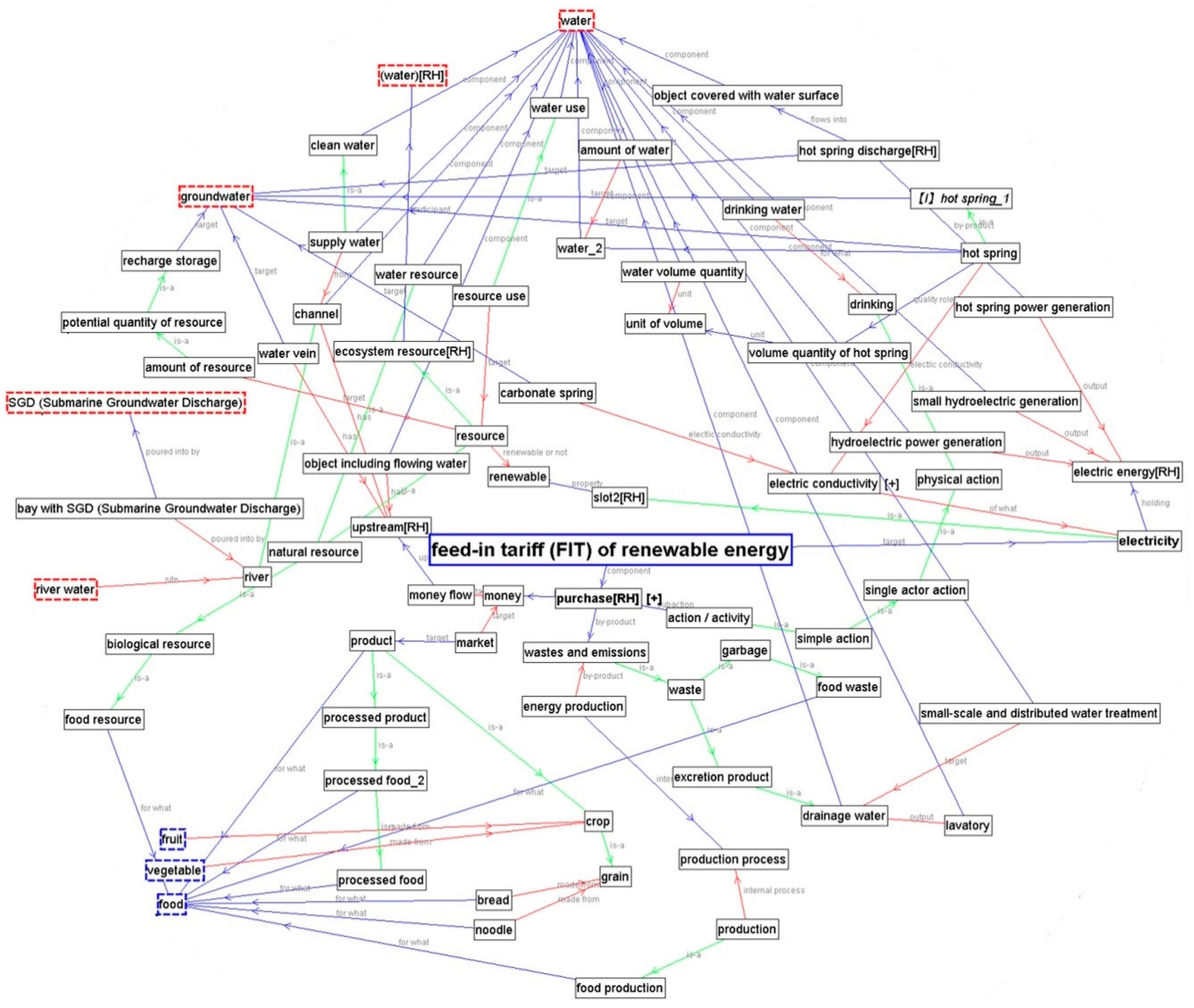
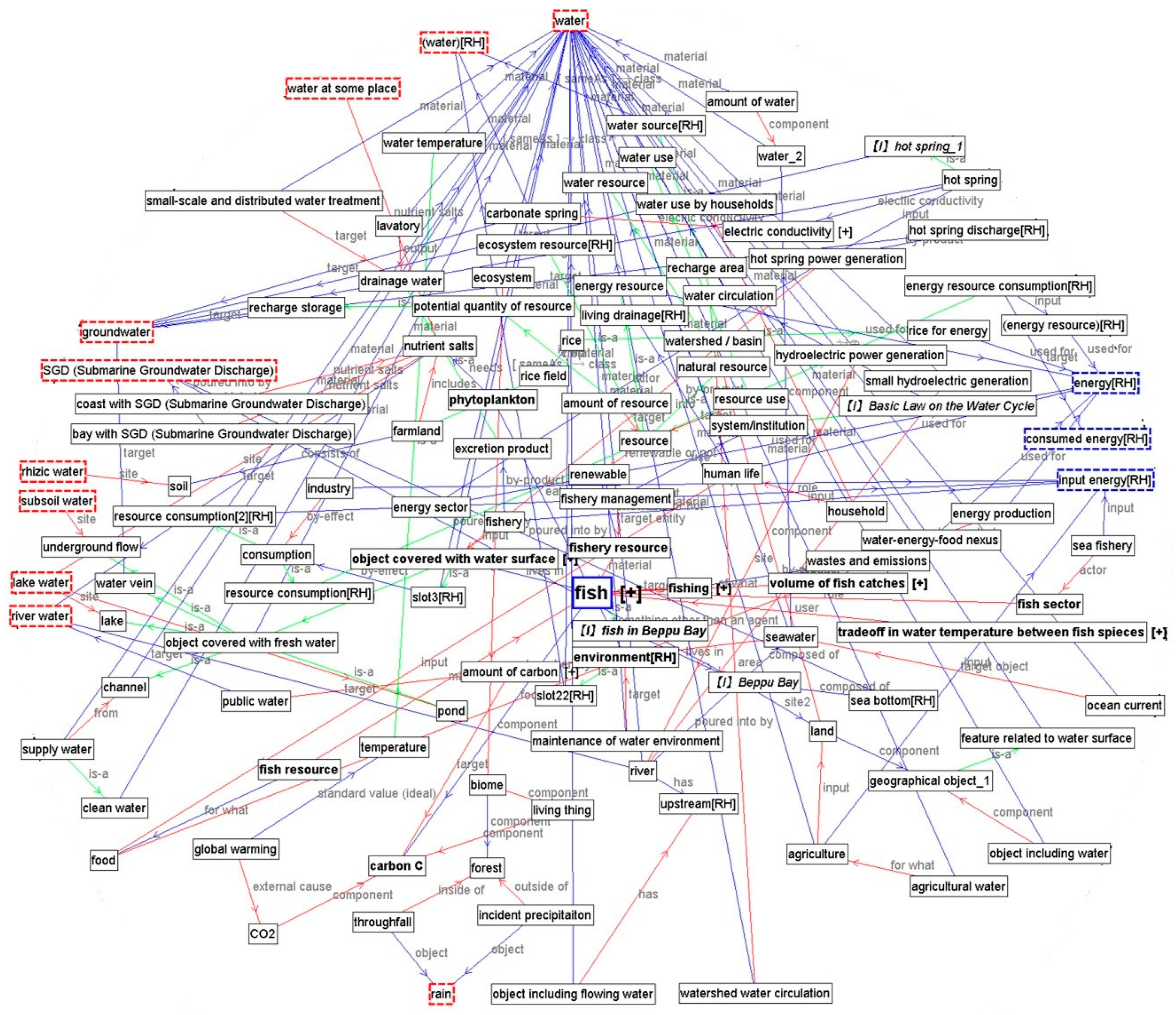
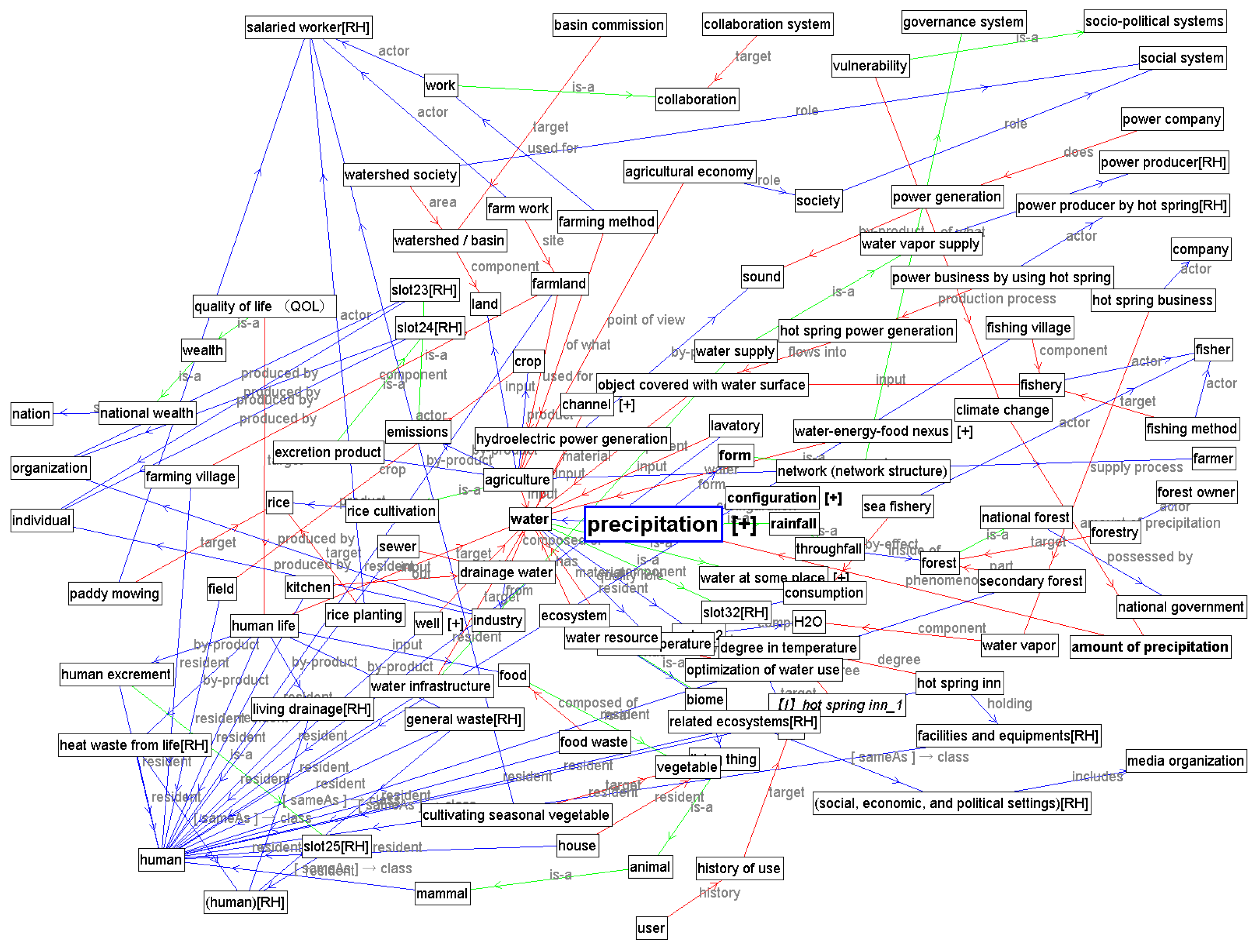
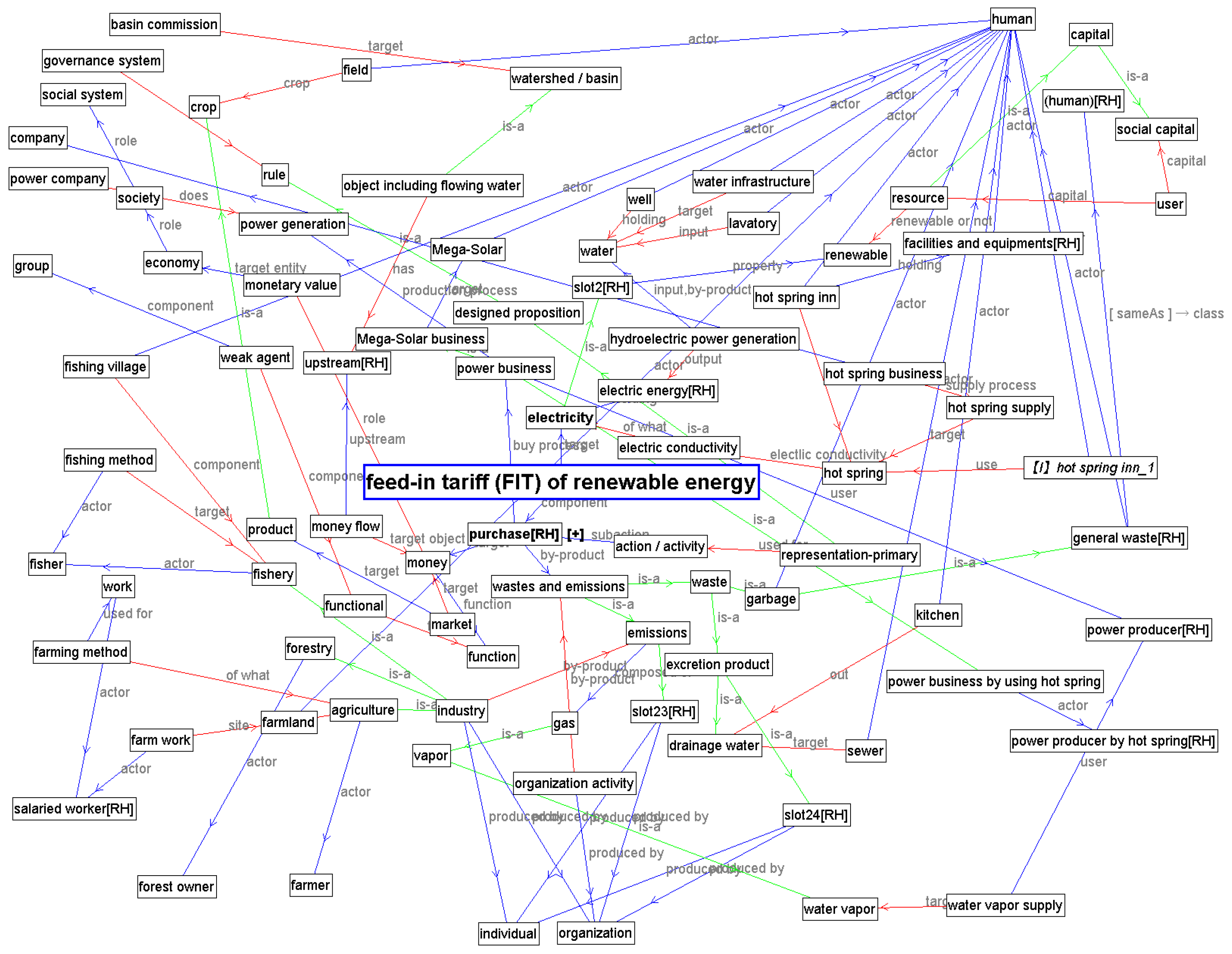
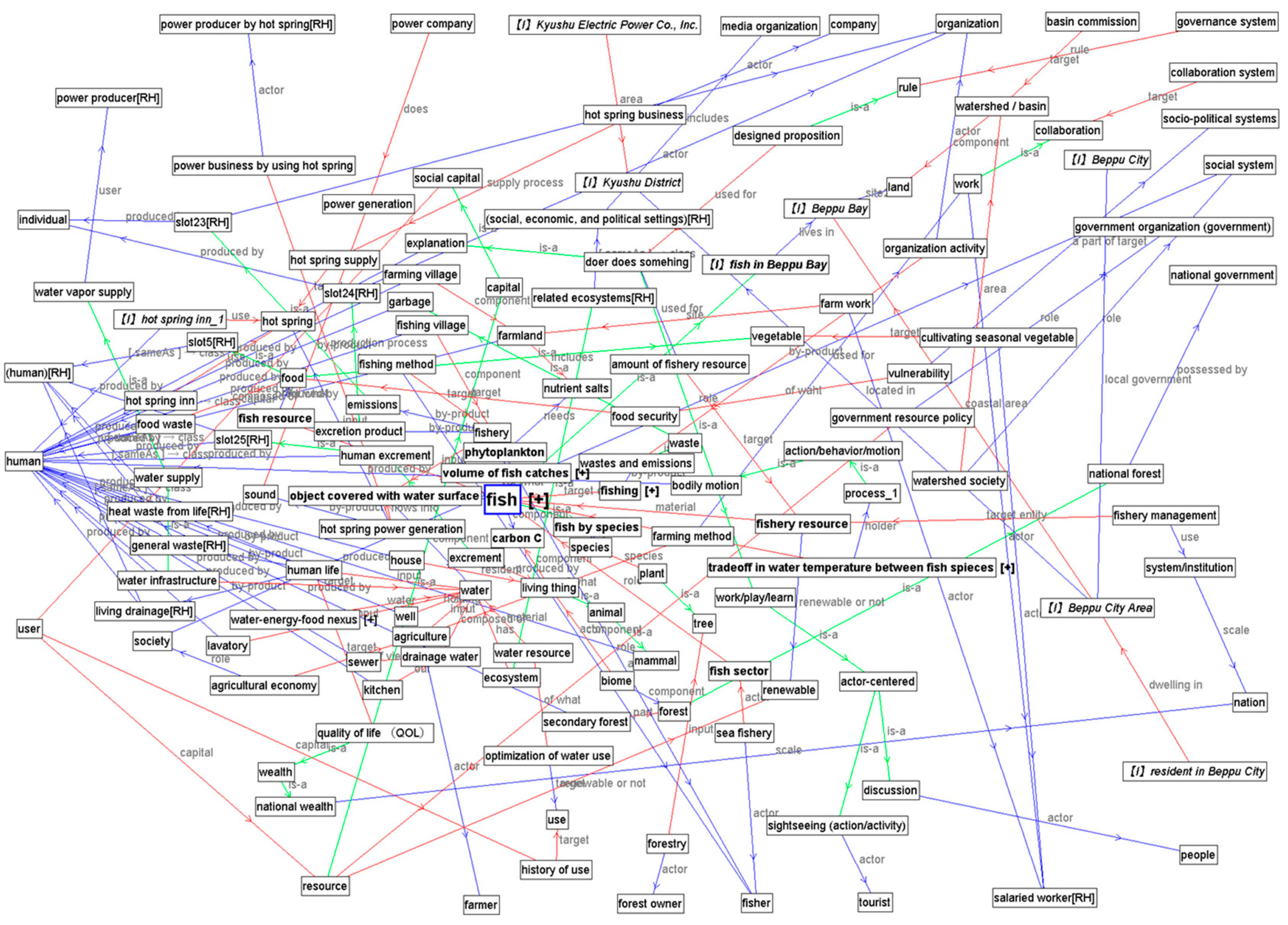
| Title | Hot Spring Drainage Water | Household Wastewater | |
|---|---|---|---|
| Hot Spring Resorts | Thermal Energy Development Facilities | ||
| Hiya River | - | - | - |
| Shin River | ✔ | - | ✔ |
| Hirata River | ✔ | ✔ | ✔ |
| Haruki River | ✔ | ✔ | ✔ |
| Sakai River | - | - | ✔ |
| Asami River | ✔ | ✔ | ✔ |
| Rank | Concept | Betweenness | Rank | Concept | Betweenness |
|---|---|---|---|---|---|
| 1 | target | 379,333.2 | 26 | Site | 64,067.9 |
| 2 | object | 280,407.2 | 27 | Has | 63,392.9 |
| 3 | component | 276,689.9 | 28 | measuring | 63,378.8 |
| 4 | role | 254,024.7 | 29 | functional | 62,196.8 |
| 5 | domain focused concept | 251,314.4 | 30 | abstract | 56,684.1 |
| 6 | semi-abstract | 188,763.9 | 31 | special | 54,015.0 |
| 7 | state | 154,942.7 | 32 | form | 51,453.6 |
| 8 | unit | 131,655.9 | 33 | number of units | 50,284.2 |
| 9 | content | 123,350.6 | 34 | area | 49,837.8 |
| 10 | referring to | 114,516.5 | 35 | agent | 49,428.2 |
| 11 | resource unit | 101,276.3 | 36 | element (chemistry) | 48,594.2 |
| 12 | actor | 99,647.6 | 37 | process state | 44,789.6 |
| 13 | quantity | 98,957.5 | 38 | amount of resource | 43,279.7 |
| 14 | user | 92,928.1 | 39 | activity | 43,104.2 |
| 15 | property | 88,573.4 | 40 | feed-in tariff (FIT) of renewable energy | 42,512.5 |
| 16 | external state | 87,920.4 | 41 | large small | 42,486.4 |
| 17 | change_2 | 86,304.6 | 42 | generic quality (attribute) | 42,078.7 |
| 18 | location | 84,149.5 | 43 | domain concept | 42,017.3 |
| 19 | on what | 80,970.2 | 44 | dependent entity | 41,645.1 |
| 20 | precipitation | 78,896.5 | 45 | actor-centered | 41,513.0 |
| 21 | material | 77,961.2 | 46 | know | 40,699.9 |
| 22 | object state | 75,477.3 | 47 | fish | 40,122.5 |
| 23 | precipitation | 71,207.2 | 48 | used for | 40,003.2 |
| 24 | value | 67,767.1 | 49 | specially dependent | 39,220.3 |
| 25 | phenomena | 64,706.8 | 50 | artifact | 38,905.2 |
© 2018 by the authors. Licensee MDPI, Basel, Switzerland. This article is an open access article distributed under the terms and conditions of the Creative Commons Attribution (CC BY) license (http://creativecommons.org/licenses/by/4.0/).
Share and Cite
Endo, A.; Kumazawa, T.; Kimura, M.; Yamada, M.; Kato, T.; Kozaki, K. Describing and Visualizing a Water–Energy–Food Nexus System. Water 2018, 10, 1245. https://doi.org/10.3390/w10091245
Endo A, Kumazawa T, Kimura M, Yamada M, Kato T, Kozaki K. Describing and Visualizing a Water–Energy–Food Nexus System. Water. 2018; 10(9):1245. https://doi.org/10.3390/w10091245
Chicago/Turabian StyleEndo, Aiko, Terukazu Kumazawa, Michinori Kimura, Makoto Yamada, Takaaki Kato, and Kouji Kozaki. 2018. "Describing and Visualizing a Water–Energy–Food Nexus System" Water 10, no. 9: 1245. https://doi.org/10.3390/w10091245
APA StyleEndo, A., Kumazawa, T., Kimura, M., Yamada, M., Kato, T., & Kozaki, K. (2018). Describing and Visualizing a Water–Energy–Food Nexus System. Water, 10(9), 1245. https://doi.org/10.3390/w10091245






